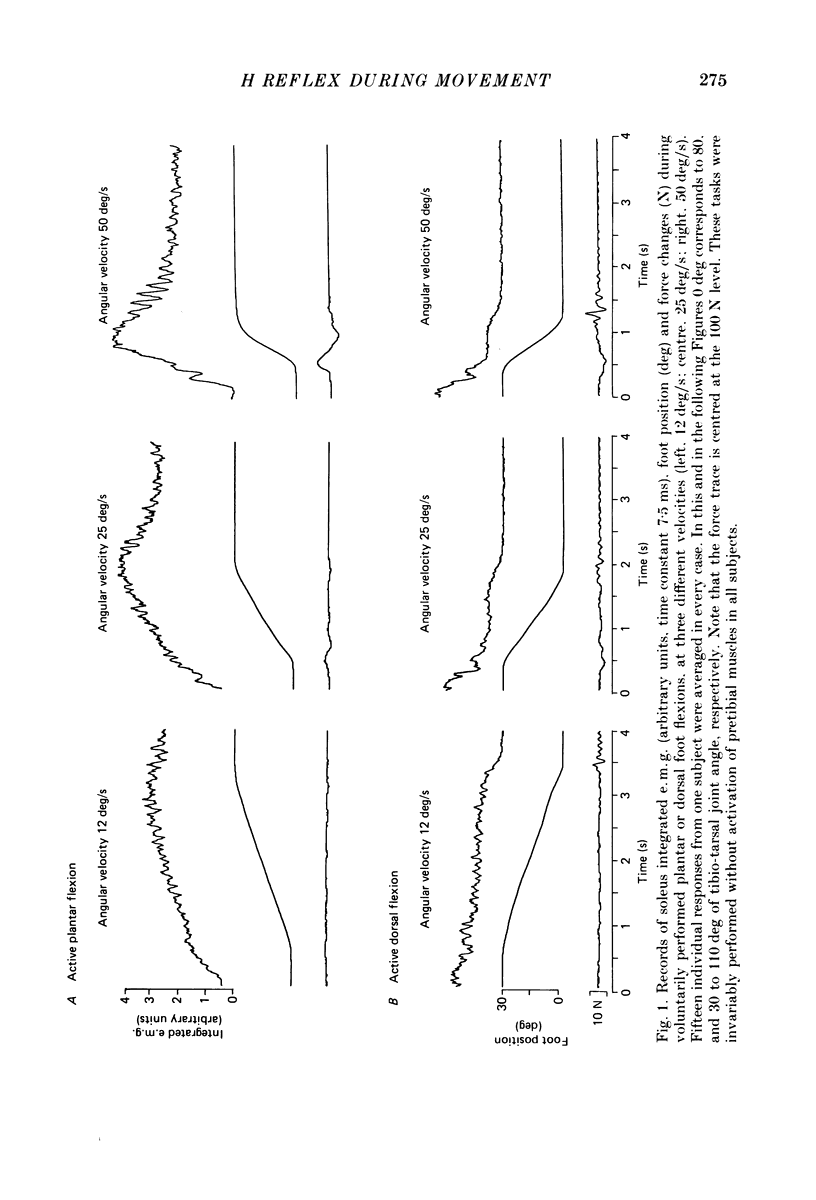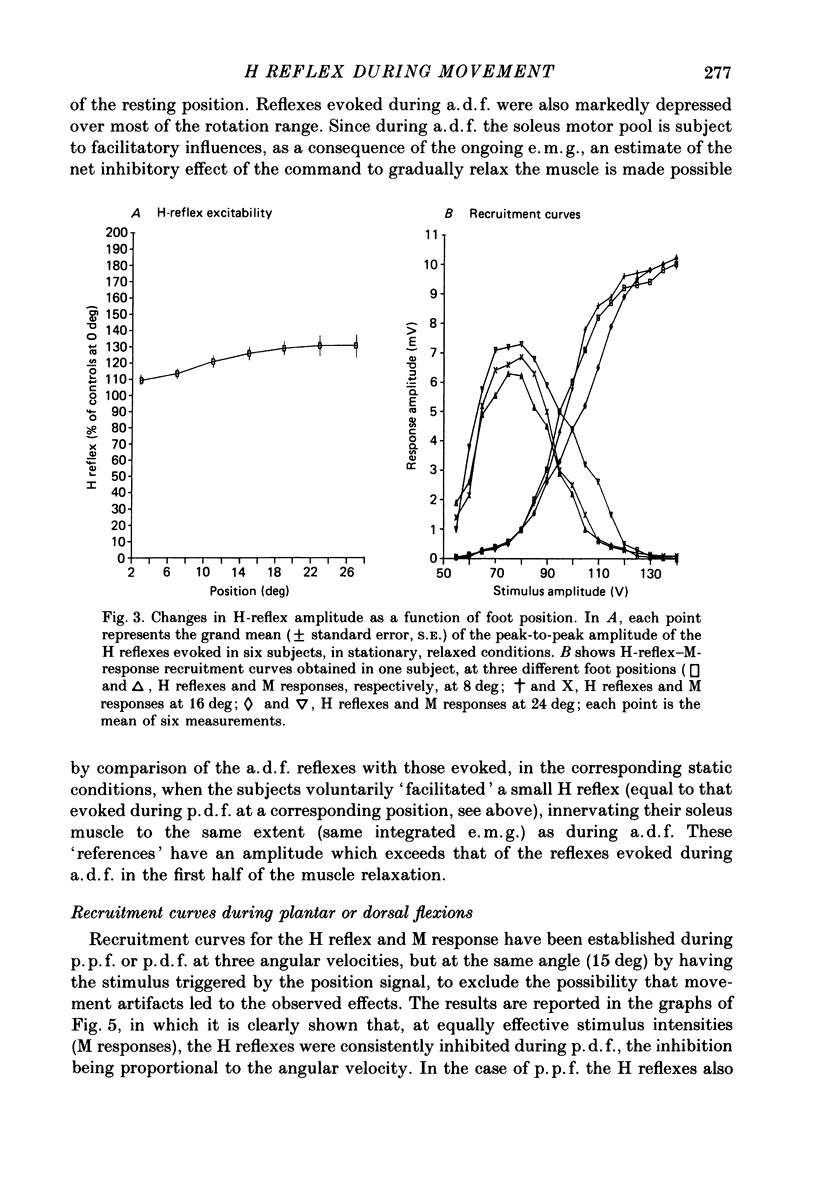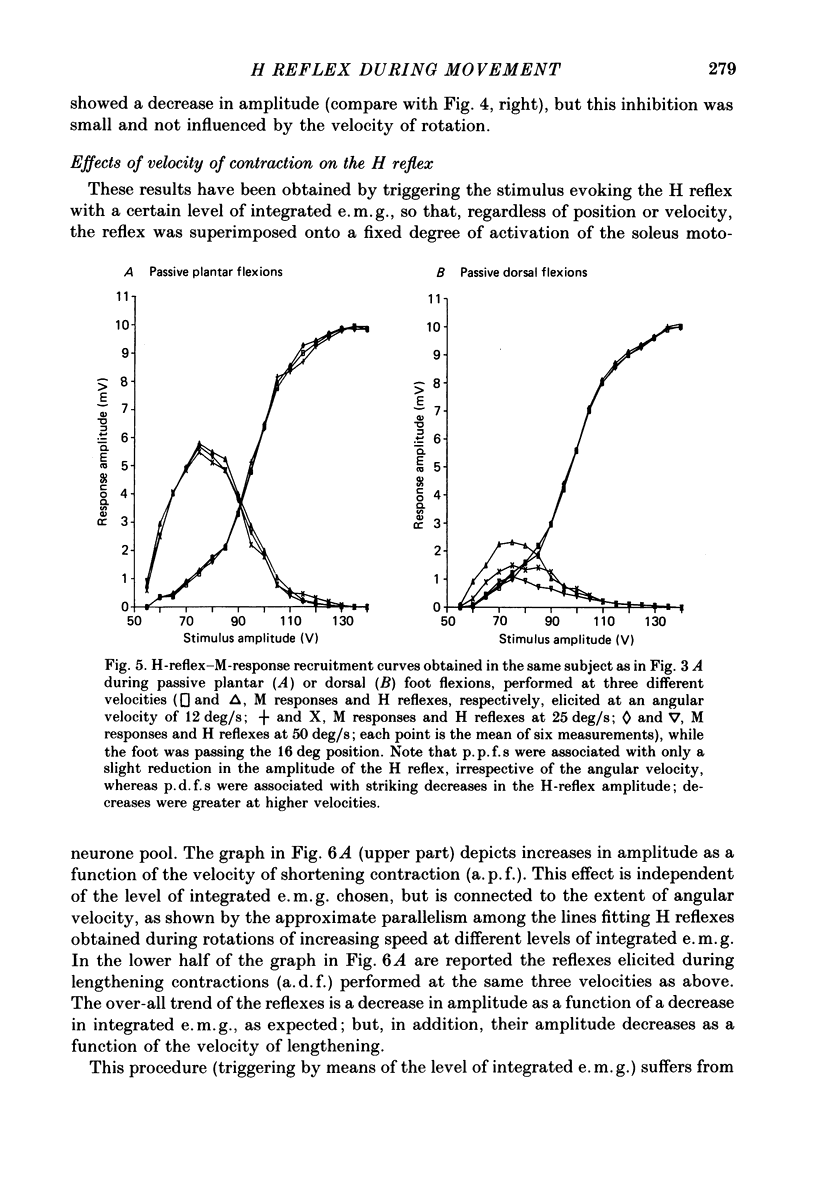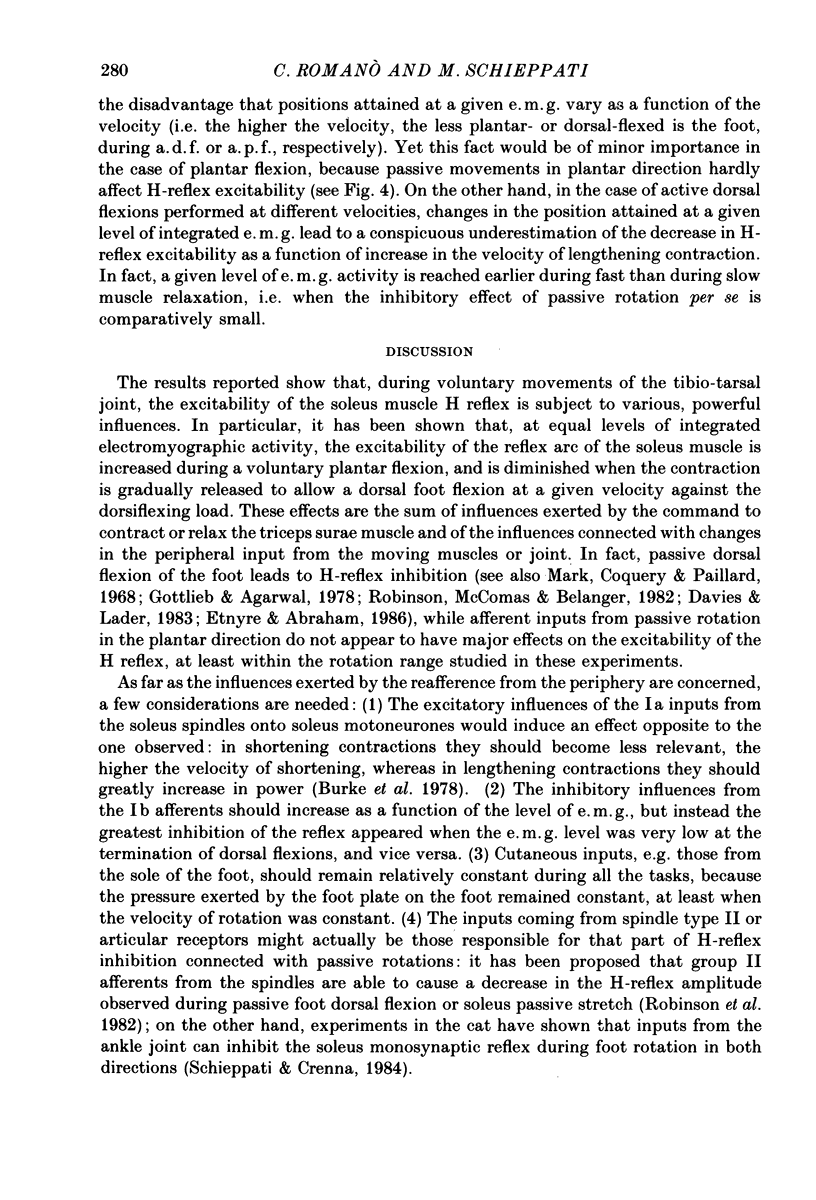Abstract
1. We investigated the possibility that increase or decrease in the monosynaptic reflex excitability of the soleus muscle in man might play a role in matching the muscle mechanical output to the voluntary command aimed at performing isotonic contractions or relaxations, at various velocities. 2. Rectified and integrated electromyographic activity (e.m.g.) and the H reflex of soleus were measured during plantar flexions against a constant load (shortening contractions) or dorsal flexions resisting the load (lengthening contraction), performed without activation of pretibial muscles. 3. At the same ankle joint angle, integrated e.m.g. was larger during shortening contractions than during lengthening contractions. During shortening contractions, integrated e.m.g. increased as a function of the velocity of plantar flexion. During lengthening contractions, integrated e.m.g. decreased as a function of dorsal flexion and angular velocity and nearly disappeared in the last part of the most rapid lengthening contractions. 4. During shortening contractions, the H reflex increased beyond the extent expected for the level of e.m.g. activity; during lengthening contractions, reduction of the H reflex below control values at rest occurred in spite of background e.m.g. activity. 5. When the level of e.m.g. activity was kept constant, the above changes in H reflex were larger in both directions as a function of the velocity of the movement. 6. Passive rotation in the dorsal direction contributed to the inhibition observed during lengthening contractions. 7. It is suggested that these changes in the excitability of the H reflex, probably presynaptic in origin, serve the purpose of appropriately modulating the rate and extent of motoneurone recruitment during shortening and lengthening contractions. This allows the foot to follow a constant-velocity path in spite of the perturbing effects of the spindle afferent inputs and of the muscle characteristics described by the force--length and force--velocity diagrams.
Full text
PDF













Selected References
These references are in PubMed. This may not be the complete list of references from this article.
- ABBOTT B. C., AUBERT X. M., HILL A. V. The absorption of work by a muscle stretched during a single twitch or a short tetanus. Proc R Soc Lond B Biol Sci. 1951 Dec 31;139(894):86–104. doi: 10.1098/rspb.1951.0048. [DOI] [PubMed] [Google Scholar]
- Angel R. W., Eppler W., Iannone A. Silent period produced by unloading of muscle during voluntary contraction. J Physiol. 1965 Oct;180(4):864–870. doi: 10.1113/jphysiol.1965.sp007736. [DOI] [PMC free article] [PubMed] [Google Scholar]
- BIGLAND B., LIPPOLD O. C. The relation between force, velocity and integrated electrical activity in human muscles. J Physiol. 1954 Jan;123(1):214–224. doi: 10.1113/jphysiol.1954.sp005044. [DOI] [PMC free article] [PubMed] [Google Scholar]
- Bigland-Ritchie B., Woods J. J. Integrated electromyogram and oxygen uptake during positive and negative work. J Physiol. 1976 Sep;260(2):267–277. doi: 10.1113/jphysiol.1976.sp011515. [DOI] [PMC free article] [PubMed] [Google Scholar]
- Burke D., Hagbarth K. E., Löfstedt L. Muscle spindle activity in man during shortening and lengthening contractions. J Physiol. 1978 Apr;277:131–142. doi: 10.1113/jphysiol.1978.sp012265. [DOI] [PMC free article] [PubMed] [Google Scholar]
- Capaday C., Stein R. B. Amplitude modulation of the soleus H-reflex in the human during walking and standing. J Neurosci. 1986 May;6(5):1308–1313. doi: 10.1523/JNEUROSCI.06-05-01308.1986. [DOI] [PMC free article] [PubMed] [Google Scholar]
- Cavagna G. A., Dusman B., Margaria R. Positive work done by a previously stretched muscle. J Appl Physiol. 1968 Jan;24(1):21–32. doi: 10.1152/jappl.1968.24.1.21. [DOI] [PubMed] [Google Scholar]
- Crenna P., Frigo C. Hindered muscle relaxation in spasticity: experimental evidence suggesting a possible pathophysiological mechanism. Ital J Neurol Sci. 1985 Dec;6(4):481–489. doi: 10.1007/BF02331042. [DOI] [PubMed] [Google Scholar]
- Etnyre B. R., Abraham L. D. H-reflex changes during static stretching and two variations of proprioceptive neuromuscular facilitation techniques. Electroencephalogr Clin Neurophysiol. 1986 Feb;63(2):174–179. doi: 10.1016/0013-4694(86)90010-6. [DOI] [PubMed] [Google Scholar]
- Gerard C., Tardieu C., Bussel B., Tardieu G. Etroite interdépendance entre les couples passifs et actifs du muscle soléaire chez l'homme: approche de la co-régulation du nombre des sarcomères et de la longueur du conjonctif musculaire. J Physiol (Paris) 1985;80(1):20–26. [PubMed] [Google Scholar]
- Gottlieb G. L., Agarwal G. C. Modulation of postural reflexes by voluntary movement. I. Modulation of the active limb. J Neurol Neurosurg Psychiatry. 1973 Aug;36(4):529–539. doi: 10.1136/jnnp.36.4.529. [DOI] [PMC free article] [PubMed] [Google Scholar]
- Gottlieb G. L., Agarwal G. C., Stark L. Interactions between voluntary and postural mechanisms of thehuman motor system. J Neurophysiol. 1970 May;33(3):365–381. doi: 10.1152/jn.1970.33.3.365. [DOI] [PubMed] [Google Scholar]
- Gottlieb G. L., Agarwal G. C. Stretch and Hoffmann reflexes during phasic voluntary contractions of the human soleus muscle. Electroencephalogr Clin Neurophysiol. 1978 May;44(5):553–561. doi: 10.1016/0013-4694(78)90122-0. [DOI] [PubMed] [Google Scholar]
- Hugon M., Massion J., Wiesendanger M. Anticipatory postural changes induced by active unloading and comparison with passive unloading in man. Pflugers Arch. 1982 Jun;393(4):292–296. doi: 10.1007/BF00581412. [DOI] [PubMed] [Google Scholar]
- Hulliger M., Vallbo A. B. The responses of muscle spindle afferents during voluntary tracking movements in man. Load dependent servo assistance? Brain Res. 1979 Apr 27;166(2):401–404. doi: 10.1016/0006-8993(79)90227-0. [DOI] [PubMed] [Google Scholar]
- Iles J. F. Responses in human pretibial muscles to sudden stretch and to nerve stimulation. Exp Brain Res. 1977 Dec 19;30(4):451–470. doi: 10.1007/BF00237637. [DOI] [PubMed] [Google Scholar]
- Katz B. The relation between force and speed in muscular contraction. J Physiol. 1939 Jun 14;96(1):45–64. doi: 10.1113/jphysiol.1939.sp003756. [DOI] [PMC free article] [PubMed] [Google Scholar]
- Mark R. F., Coquery J. M., Paillard J. Autogenetic reflex effects of slow or steady stretch of the calf muscles in man. Exp Brain Res. 1968;6(2):130–145. doi: 10.1007/BF00239167. [DOI] [PubMed] [Google Scholar]
- Marsden C. D., Merton P. A., Morton H. B. Servo action in the human thumb. J Physiol. 1976 May;257(1):1–44. doi: 10.1113/jphysiol.1976.sp011354. [DOI] [PMC free article] [PubMed] [Google Scholar]
- Robinson K. L., McComas A. J., Belanger A. Y. Control of soleus motoneuron excitability during muscle stretch in man. J Neurol Neurosurg Psychiatry. 1982 Aug;45(8):699–704. doi: 10.1136/jnnp.45.8.699. [DOI] [PMC free article] [PubMed] [Google Scholar]
- Roll J. P., Vedel J. P. Kinaesthetic role of muscle afferents in man, studied by tendon vibration and microneurography. Exp Brain Res. 1982;47(2):177–190. doi: 10.1007/BF00239377. [DOI] [PubMed] [Google Scholar]
- Sale D., Quinlan J., Marsh E., McComas A. J., Belanger A. Y. Influence of joint position on ankle plantarflexion in humans. J Appl Physiol Respir Environ Exerc Physiol. 1982 Jun;52(6):1636–1642. doi: 10.1152/jappl.1982.52.6.1636. [DOI] [PubMed] [Google Scholar]
- Schieppati M., Crenna P. Excitability of reciprocal and recurrent inhibitory pathways after voluntary muscle relaxation in man. Exp Brain Res. 1985;59(2):249–256. doi: 10.1007/BF00230904. [DOI] [PubMed] [Google Scholar]
- Schieppati M., Crenna P. From activity to rest: gating of excitatory autogenetic afferences from the relaxing muscle in man. Exp Brain Res. 1984;56(3):448–457. doi: 10.1007/BF00237985. [DOI] [PubMed] [Google Scholar]
- Schieppati M., Crenna P. Natural cutaneous stimulation induces late and long-lasting facilitation of extensor motoneurons in the cat. Brain Res. 1984 Feb 20;293(2):259–267. doi: 10.1016/0006-8993(84)91233-2. [DOI] [PubMed] [Google Scholar]
- Schieppati M., Nardone A., Musazzi M. Modulation of the Hoffmann reflex by rapid muscle contraction or release. Hum Neurobiol. 1986;5(1):59–66. [PubMed] [Google Scholar]
- Schieppati M., Poloni M., Nardone A. Voluntary muscle release is not accompanied by H-reflex inhibition in patients with upper moto neuron lesions. Neurosci Lett. 1985 Oct 24;61(1-2):177–181. doi: 10.1016/0304-3940(85)90421-5. [DOI] [PubMed] [Google Scholar]
- Vallbo A. B. Discharge patterns in human muscle spindle afferents during isometric voluntary contractions. Acta Physiol Scand. 1970 Dec;80(4):552–566. doi: 10.1111/j.1748-1716.1970.tb04823.x. [DOI] [PubMed] [Google Scholar]
- Vallbo A. B., Hulliger M. Independence of skeletomotor and fusimotor activity in man? Brain Res. 1981 Oct 26;223(1):176–180. doi: 10.1016/0006-8993(81)90819-2. [DOI] [PubMed] [Google Scholar]
- Verrier M. C. Alterations in H reflex magnitude by variations in baseline EMG excitability. Electroencephalogr Clin Neurophysiol. 1985 Jun;60(6):492–499. doi: 10.1016/0013-4694(85)91109-5. [DOI] [PubMed] [Google Scholar]


